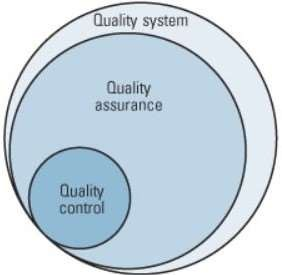
A quality assurance/quality control (QA/QC) program is critical for successful construction projects, as it can prevent errors and defects from occurring in the first place and identify and correct them after they occur to improve quality. This is essential for delivering high-quality projects, meeting customer expectations, and guaranteeing quality standards in the construction industry. Incorporating a QA/QC program can improve the overall quality of construction projects.

(Image source: asq.org)
A quality assurance checklist is a list of QA checks that should be performed at various project stages. QA checklists are used to ensure that all aspects of a project are being monitored and that any potential problems are identified and addressed.
QA checklists can also help to improve communication between project managers, quality control specialists, and subcontractors.
When Should Contractors Use a Quality Control checklist?
Contractors should use a quality control checklist;
-
When there is a first-time quality problem with sub-contractors: This is one of the most compelling reasons to use a quality control checklist, as it allows you to identify and address any issues that may arise quickly. Quality problems with subcontractors can be very costly. For example, if the subcontractor misses a key detail in their work, it can cause structural defects or safety issues that can delay progress or result in additional costs.
-
When known issues are missed: Quality assurance checklists are also used to identify and address any known quality issues that may arise. For example, if a particular type of material has been known to cause issues in the past, your quality control checklist should include checks at various project stages to ensure that this material is properly handled and installed.
-
To demonstrate compliance with the project requirements: Quality assurance checklists are often used to demonstrate compliance with specific project requirements. For instance, if the customer has specified certain standards and quality checks that must be met, your project team can use a quality control checklist as a tool for ensuring that all aspects of the project meet these standards.
-
When field personnel has varying levels and competencies in inspection accuracy or construction knowledge: Quality control checklists can also be useful for ensuring that all QAQC field personnel are consistent with inspections. Quality control specialists may also have varying levels of expertise and training, so incorporating a quality assurance checklist in your Quality Assurance Quality Control (QAQC) program can help to ensure consistency and accuracy in inspection results.
Functional Goals of QA/QC Inspection Checklists
The main goals of a QA checklist are:
-
Allowing work to be completed according to project specifications.
-
Improving inspection productivity by eliminating administrative steps from daily routines.
-
Helping the team learn from mistakes, so they are not repeated.
Key Inspection Checklists of a QA/QC Construction Program
You need five inspection checklists for a successful QA/QC construction checklist program.
1. Checklists for Inspecting and Documenting Proper Completions
Having checklists for inspecting and documenting proper completions is crucial for any quality control and assurance program. This ensures that all trade specialties, from site work to finishes, are accounted for and properly documented.
2. Checklists for Checking the Receipt of Materials and Equipment
Another critical element of a successful quality control and assurance program are checklists for checking the receipt of materials and equipment. These checklists should include the option of attaching images of delivery tickets to ensure that all materials and equipment have been received.
3. Checklists for Review and Acceptance of Inspection Reports from Third Parties
To have a successful quality control and assurance program, you must also have checklists to review and accept reports by third parties. These checklists will help you keep track of deficiencies discovered by third-party inspectors and ensure that they are corrected promptly.
4. Checklists Inspectors Use for Documenting Deficiencies
Another vital component of a successful quality control and assurance program is checklists that inspectors use to document deficiencies. These checklists help to ensure that all deficiencies are properly documented throughout the QC process and that the QA team and all responsible parties are notified on time so that they can be corrected.
5. Checklists Project Owners Can Use for Documenting Punchlists, Acceptance of Corrections, and Final Approvals
Finally, having checklists that project owners can use for documenting punch lists, acceptance of corrections, and final approvals is essential for any quality control and assurance program. These checklists help ensure that all punch list items are properly documented and that corrective actions are taken promptly. They also help ensure that final approvals are given in a timely manner so the project can be completed on schedule.
How to Get to the Next Level with FTQ360
Ensuring the success of a construction project requires meticulous attention to every specific scope of work. Implementing a quality assurance/quality control (QA/QC) program is crucial in achieving this goal, and using digital checklists can streamline the process. We believe that our market-leading solution can provide guidance in managing QA/QC, ensuring that every aspect of the project meets the required quality standards. Below is how to get to the next construction quality level with FTQ360:
-
Use FTQ360 templates for daily reports and deficiency reporting.
-
Add your subcontractor list to FQ360. The tool comes with ready-to-receive punch items.
-
Automate routine deficiency notifications by activating daily emails.
-
Activate the weekly punch list reports feature for subcontractors and project personnel.
-
Use exception management to deal with overdue deficiencies using open-item dashboards.
-
To avoid recurring QAQC problems, review FTQ360 dashboards for any subcontractor deficiencies and work with those falling behind to help them improve.
-
FTQ360 also has a "days to fix" feature that helps track sub-contractor performance and determine if there is a need for more intensive project oversight.
With these tools and features, you can easily achieve the next level of quality control and assurance. So, if you're looking for a QA/QC solution that will streamline your projects and make your job easier than ever before, look no further than FTQ360. With our user-friendly platform and comprehensive features, we offer everything you need to run a successful QA/QC program. Sign up for a free demo to learn more.
![[FREE GUIDE] How to Quickly Improve Your Subcontractors Performance](https://no-cache.hubspot.com/cta/default/3353989/fac47599-fc2e-4c85-89b3-d0fc8a6cb984.png)
